Menu
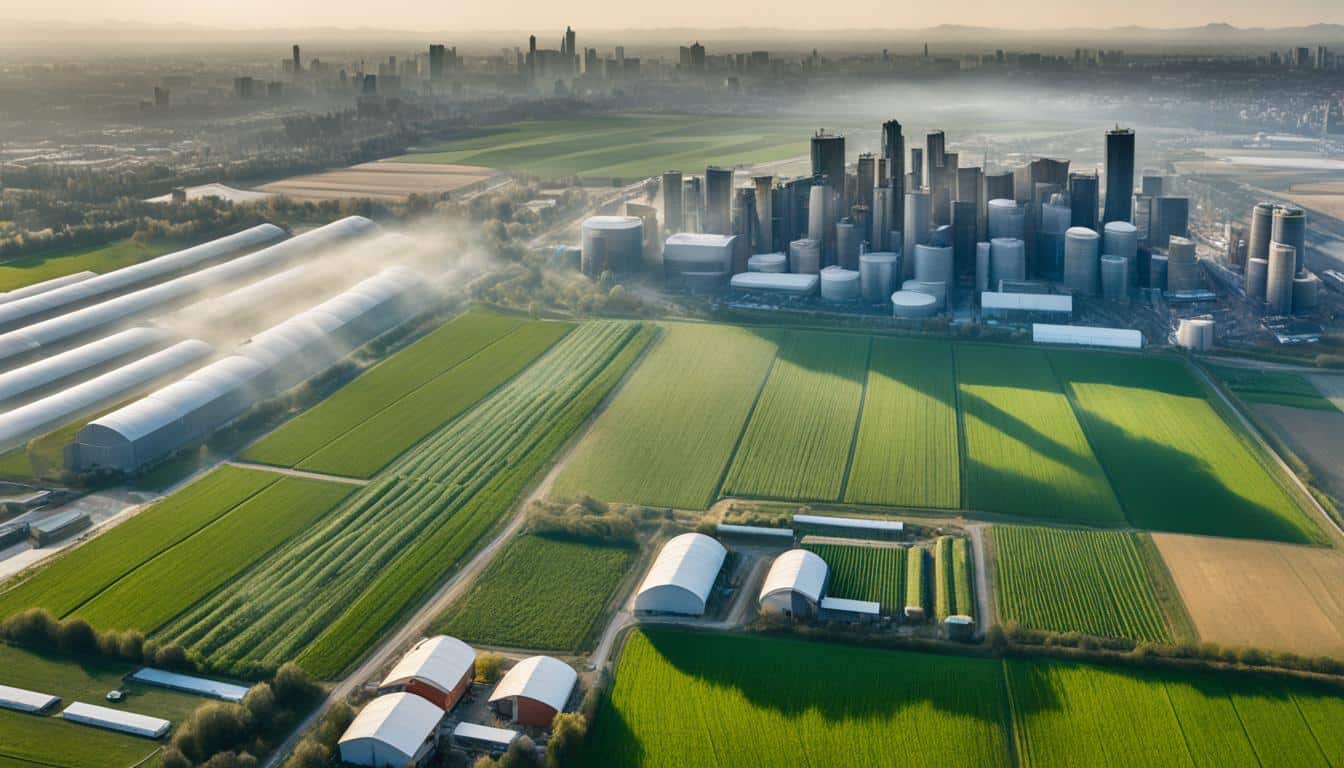
Did you know around 93% of ammonia emissions in the EU come from farming? This high number shows how much farming affects the air quality. Livestock farming and using synthetic fertilisers add a lot to this pollution. So, farmers need to know the EU’s rules on air quality to farm in a way that’s better for our planet.
Livestock also create methane that leads to damaging ground ozone. This ozone harms crops. Besides, fires that burn biomass and forests add to the problem with PM10 particles. The EU’s plan, known as the Common Agricultural Policy (CAP) 2023-27, aims to make agriculture cleaner. It supports farmers with both rules to follow and money to encourage cleaner, greener ways of farming.
The European Union is serious about keeping the air clean. It has created rules through the Ambient Air Quality Directives. These rules set tough standards for air purity. They’re based on advice from the World Health Organisation. The EU’s efforts to improve air quality have shown progress. This shows Europe’s aim to protect people and the planet.
The EU has clear rules for 12 pollutants. These include things like sulphur dioxide and lead. Over 4,000 air quality stations across Europe help to check the air. If the rules are broken, countries must plan to fix things. This is to lower pollution and keep people aware.
These European clean air directives align with World Health Organisation recommendations and focus on achieving zero pollution by 2050.
Farmers must follow the EU’s Air Quality Standards. These rules greatly impact how they farm. Not sticking to these rules can have serious consequences. For instance, a tight limit for fine particulate matter was recently set. This change shows how important air quality is to the EU.
Farmers must carefully manage their activities to meet these new standards. This shows their vital role in improving air around us.
| Pollutant | Limit Value | Exceedances Permitted |
|---|---|---|
| Sulphur Dioxide (SO2) | 350 µg/m3 for 1 hour, 125 µg/m3 for 24 hours | 24 per year |
| Nitrogen Dioxide (NO2) | 200 µg/m3 for 1 hour, 40 µg/m3 for 1 year | 18 per year |
| PM10 | 50 µg/m3 for 24 hours, 40 µg/m3 for 1 year | 35 per year |
| PM2.5 | 25 µg/m3 for 1 year (2010 target), 20 µg/m3 for 1 year (2015 limit) | Not specified |
| Lead (Pb) | 0.5 µg/m3 for 1 year | Not specified |
| Carbon Monoxide (CO) | 10 mg/m3 for maximum daily 8-hour mean | Not specified |
| Benzene | 5 µg/m3 for 1 year | Not specified |
| Ozone (O3) | 120 µg/m3 for maximum daily 8-hour mean | 25 days averaged over 3 years |
Agriculture is a main cause of air pollution in the European Union. It releases a lot of ammonia from farming activities. Ammonia emissions from agriculture make up 93% of the total in the EU. This leads to harmful effects on the environment, like the pollution of water and the acidification of soils.
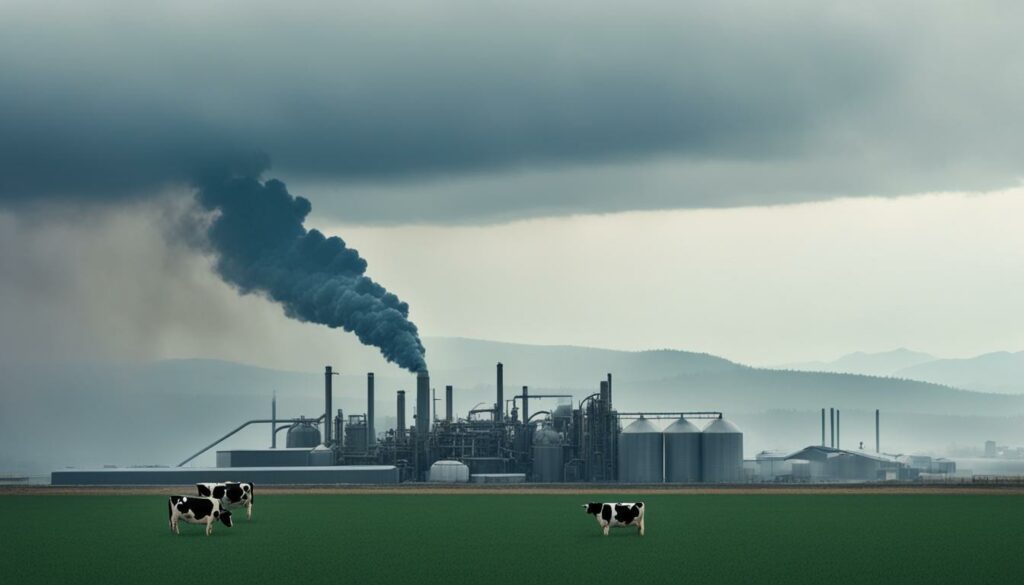
Most ammonia emissions come from livestock manure and the use of chemicals in farming. This causes big problems for the environment. Between 1990 and 2015, the amount of ammonia in the air dropped by 23% in the EU. But, these levels have started to go up in some places since. The CAP 2023-27 plan is working with the European Green Deal to reduce this pollution. It aims to control ammonia emissions better.
Particulate matter, like PM10, comes from burning trees and farm residues. This makes the air dirty and is bad for health. 15 EU countries are working together on this issue. They are trying to cut down on emissions, especially of ammonia and methane. This teamwork shows plans to tackle air pollution together. The CAP Strategic Plans help countries do more to stop this pollution close to home.
Methane is a big player in air quality, mainly in farming. It’s more potent than carbon dioxide when it comes to heating our planet. This point is why it’s so important to control methane from farms. It’s vital for both our weather and the health of our crops.
Most of the methane from farms comes from the stomachs of cows. This is because a natural part of their digestion makes methane. In the EU, nearly 70% of farm methane comes from cows. But, beyond being powerful, this methane helps make harmful air pollution that hurts crops.
Farm methane does more than warm our planet. It hurts our crops directly. It makes an air pollutant that damages the plants and slows down how much food they make. Fixing how we deal with this methane can make the air cleaner. This would protect our crops and our health.
If we cut methane emissions by half in the next 30 years, we could cool the earth a bit. This strategy is backed by experts. It shows managing methane well will help our environment and farms. So, it’s a big deal for everyone.
The Common Agricultural Policy (CAP) is pivotal in making the air across the European Union cleaner. It does this by pushing for farming in ways that are better for the environment. There are many rules and steps to follow to lower the amount of harmful substances released into the air through farming.
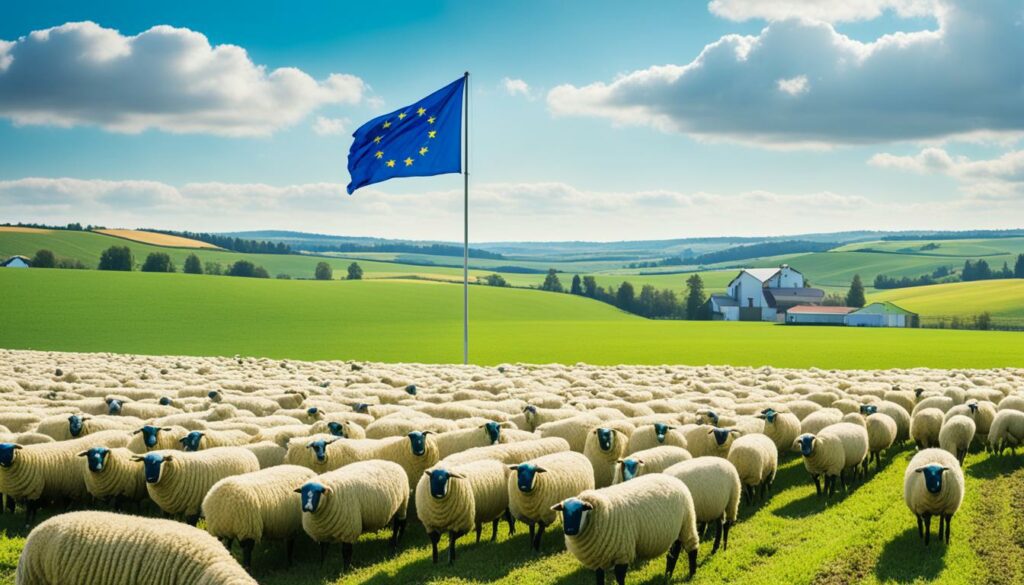
CAP aims to reduce air pollution, focusing on decreasing harmful ammonia. This gas comes mostly from livestock and certain fertilisers. From 2023 to 2027, the CAP is giving more support to reduce this and other pollutants. The European Green Deal inspires these efforts, aiming for cleaner air and a healthier environment. It’s helping out a lot with funds going to special programmes that ask farmers to use methods that keep the air cleaner.
Through the CAP, farmers are nudged towards eco-friendly farming methods. They must stick to tough rules that help the environment if they want to get paid through CAP. For instance, they can’t burn certain farm leftovers since that makes dirty air. They also get money for making their farms more eco-conscious, thanks to various countryside programmes.
The CAP also keeps a close eye on how things are going with the air and the environment. It tracks changes and checks if what it’s doing is really helping. An important part of this is the European effort to bring new, less polluting ways to farm animals. This should further help improve the air by lowering harmful gas emissions.
| Indicators | Data | Outcome |
|---|---|---|
| Agriculture’s Ammonia Emissions | 93% of EU Total | High Impact |
| Ammonia Emissions Decline | 1990-2015: 23% | Positive Trend |
| CAP Funding for Climate Actions (2014-20) | €104bn (25% of CAP) | Significant Support |
| Agricultural Emissions Decline | 1990-2017: 21% | Without Production Loss |
| Rural Development Programmes | 27 Programs in 15 Countries | Wide Implementation |
Farmers in the European Union face strict rules. They aim to keep the air clean. This is key for protecting the environment and helping farming thrive. To keep the air quality high, farmers must follow these rules for a safe and green future.
The EU focuses hard on reducing air pollution. It sets out clear rules for farmers to follow. These rules help cut down on harmful gases like ammonia and methane. Agencies like the Copernicus service help keep an eye on air quality. They give farmers important info to meet these rules.
Not obeying the EU Clean Air Directives can bring big problems. It’s bad for health, costing money and lives. To fight this, the EU wants to make the air cleaner. They set major goals for 2030, like a 55% cut in premature deaths due to air pollution. So, farming must change to help reach these goals and keep our air safe.
| Aspect | Details | Key Measures |
|---|---|---|
| Compliance Requirements | Farmers must adhere to directives to limit emissions of pollutants | Utilise CAMS data, implement pollutant reduction techniques |
| Penalties for Non-Compliance | Fines and enforced air quality plans | Adoption of sustainable practices, alignment with EU guidelines |
In farming, nitrogen fertilisers are a big source of ammonia in the air. To cut this pollution, farmers should put these fertilisers directly into the soil. This stops a lot of the fertilisers from turning into gas and going into the air.
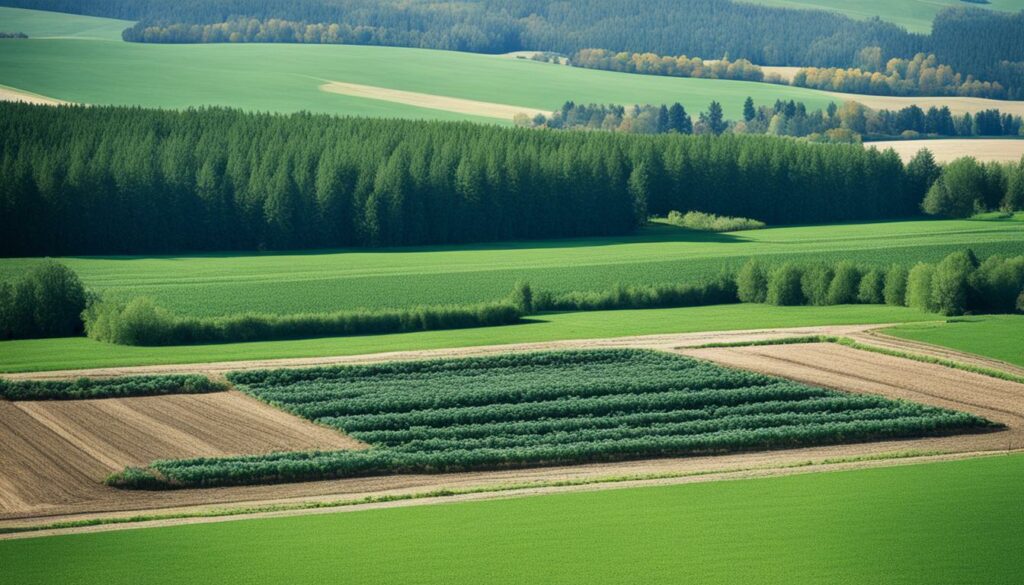
Mixing nitrogen fertilisers into the soil is a big help in lowering ammonia in the air. This way, plants can take up the nutrients better, and less nitrogen gets to escape into the air. Doing this is key for growing more crops and polluting less.
Keeping manure and slurry in the right place is crucial. Using covered tanks or lagoons can keep the air from them, lowering ammonia in the process.
Also, regular upkeep and wet scrubbers are effective in controlling emissions. Wet scrubbers turn ammonia gas into liquid, making it safe or usable as fertiliser.
The European Union’s Common Agricultural Policy (CAP) 2023-27 is into supporting these steps. It gives funds to encourage these good practices, showing a strong desire to lessen pollution. With these techniques, farmers can protect the planet and keep their farms going strong.
| Technique | Benefit | Implementation |
|---|---|---|
| Incorporating Nitrogen Fertilisers | Reduces volatilisation and ammonia emissions | Direct application into the soil using precision tools |
| Wet Scrubbers | Captures and converts ammonia gas | Installation in livestock and manure management facilities |
| Covered Storage Solutions | Minimises exposure to air | Investment in covered tanks or lagoons |
These methods are great for using less nitrogen fertilisers. They also match with EU goals of cleaner air and greener farming. By following these steps, we move closer to a farming future that’s good for everyone.
The CAP 2023-27 introduces new eco-schemes and financial boosts. These aim to help farmers lower their emissions and use sustainable methods. This is a great chance for farmers to be more eco-friendly. They can also get support from the big budget set aside for these plans.
Farmers all over the EU can get involved with the eco-schemes. They can use new methods to cut down on their farm’s harmful outputs. The CAP also gives more help to fight climate change. It aims to achieve no net greenhouse gas emissions by 2050.
There’s a big push towards using cleaner farming technologies and methods. Sharing new knowledge and keeping up with the latest in innovations makes these plans work better.
Money for these eco-schemes comes from the CAP’s funding. In the 2014-20 period, €104 billion was used for these actions. For the next CAP period, funding is also looking good.
Great soil management in agriculture reduces harm to the environment and makes farms better. It stops soil from getting worse and keeps the whole ecosystem healthy.
Rotating crops is key in keeping the soil good. It cuts down on pests and diseases, makes the soil more fertile, and boosts crop output. This way of planting stops too much use of fertilisers, which can harm the air. Knowing the crop rotation benefits is vital for a healthy farm.
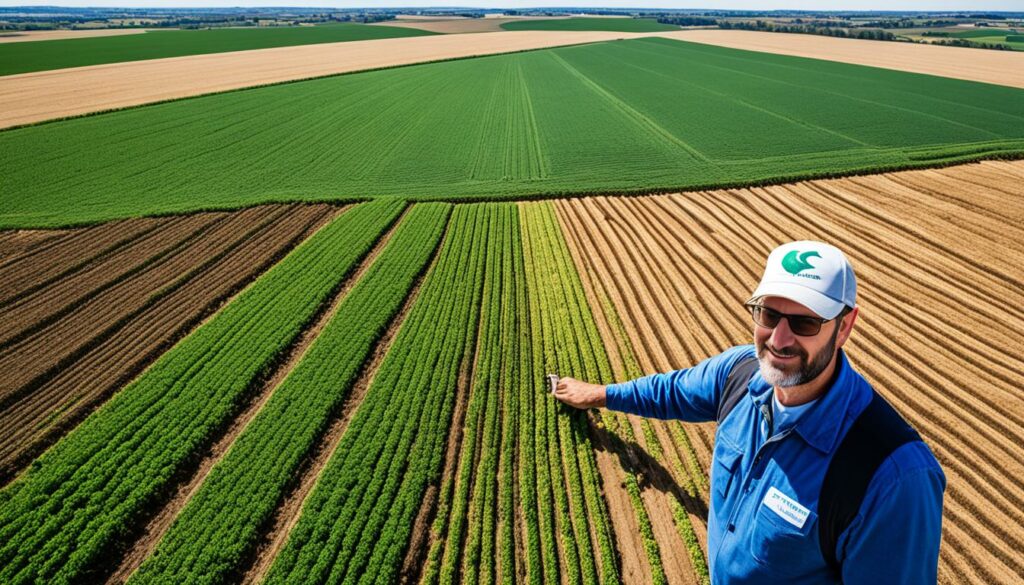
Using less tillage is very important for soil management in agriculture too. It keeps the soil’s structure and nutrients, holds more water, and lowers erosion. So, the air gets cleaner. Farmers using these methods are in line with efforts to have sustainable farms in the EU.
Biological control in farming helps the air. It uses less chemicals which is good for the environment. Two key ways to do this are by planting cover crops and using integrated pest management.
Cover crops are very important for air quality. They cover the soil, stopping dust and preventing erosion.
This keeps the soil healthy, lowering levels of dust or dirt in the air. These crops also soak up nitrogen. This means less need for chemical fertilisers and reduced ammonia in the air. So, planting cover crops is great for air quality.
Integrated Pest Management (IPM) is about dealing with pests wisely. It uses natural, and not just chemical, solutions.
IPM helps cut down on harmful fumes from pesticides. This keeps our air cleaner. By using IPM, farmers can protect their crops without harming the environment.
The European Innovation Partnership (EIP-AGRI) is key in boosting agricultural innovation. It tackles air quality issues directly. It helps fund projects aiming to sharply cut down pollutants from farm work.
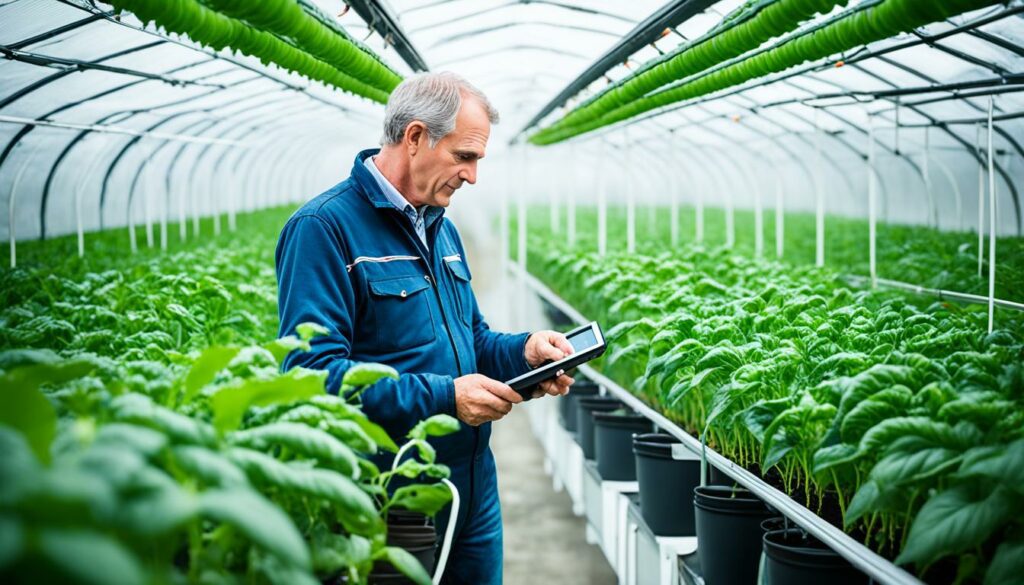
EIP-AGRI is crucial for spreading agricultural innovation in Europe. It gets farmers, scientists, and others to work together. They try to find ways to lower harmful emissions like ammonia and fight climate change.
An example of this work is a team that focused on cutting greenhouse gases in animal farming. These projects show how farming methods can improve. They have a big impact on the planet’s health. EIP-AGRI projects show that research can lead to real benefits for the farming community and our world.
Air quality monitoring is crucial in the European Union. The EU boasts more than 4,000 monitoring stations, making it a global leader. These stations play a key role by collecting data for decision-making and informing the public about air quality issues.
EU’s monitoring stations are top-notch, fitted with advanced sensors. They measure pollution such as nitrogen oxides, fine particulate matter, sulphur dioxide, ammonia, and ozone. In 2021, these stations recorded alarming figures, linking 253,000 deaths to chronic fine particulate matter exposure, among other pollutants.
A primary task for the EU’s network is to share public air quality information. The European Air Quality Index, powered by station readings, provides up-to-the-minute air quality status. This information empowers the public to take steps towards a cleaner environment. It also encourages actions that reduce air pollution.
Through directives like the NECD, Member States receive goals for pollution reduction. These goals target harmful substances such as NOx and PM2.5. While some countries achieved their emissions targets by 2021, others fell short.
Efforts like strict monitoring and information sharing are key in the fight against air pollution. They aid in improving public health. A transparent process of monitoring and sharing air quality data is vital across the EU. It ensures that ongoing initiatives to enhance air quality continue, thus safeguarding the EU’s population.
Air quality severely impacts farm output. Ground-level ozone is a big part of the problem, causing harm to crops. It reduces crop yield, harms plant variety, and impacts forests. This is a big worry for farmers everywhere.
Ground-level ozone, or O3, harms plant tissue and photosynthesis. This leads to lower crop yields. In 2019, wheat harvests across places like Greece and Cyprus saw 8% to 9% less produce. High ozone levels in key wheat-producing spots caused massive financial losses. France alone lost EUR 350 million.
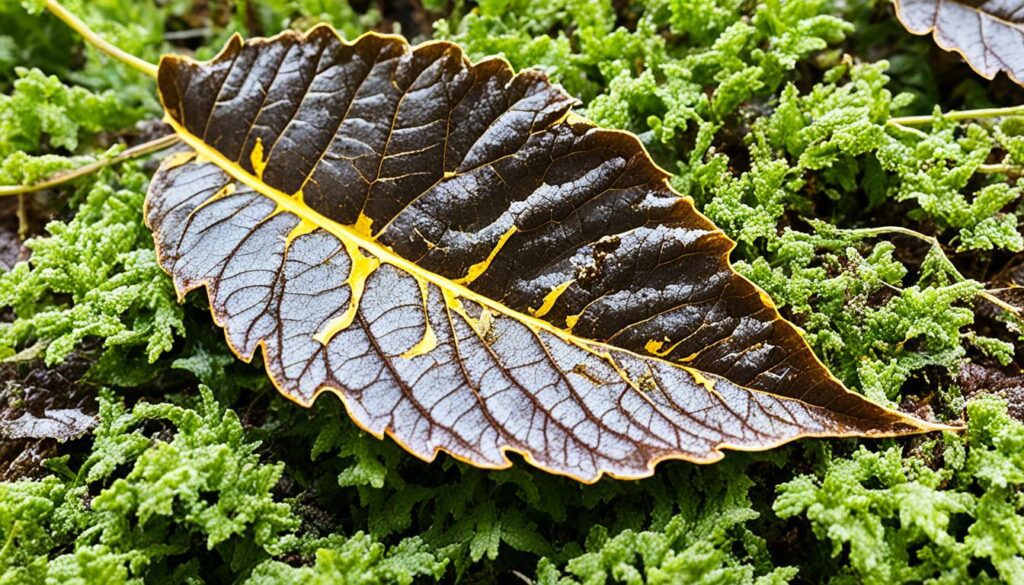
Ozone’s impact on crops is economically significant. In 2019, Europe saw EUR 1.418 billion in wheat yield losses due to ozone. In 2020, 77% of farmland in the EEA-32 faced high ozone levels, reducing yields further. During a heatwave, about half of the farmland exceeded safe ozone levels, adding to farmers’ worries.
Air pollution on a global level could cut staple crop yields by 26% by 2030. This is a threat to food security and the economy. It’s crucial we act to control ozone damage and its effects on a worldwide scale.
| Country | 2019 Wheat Yield Loss (%) | Economic Losses (EUR) |
|---|---|---|
| France | 8% – 9% | 350 million |
| Germany | 8% – 9% | Contributing to total EUR 1.418 billion |
| Poland | 8% – 9% | Contributing to total EUR 1.418 billion |
| Turkey | 8% – 9% | Contributing to total EUR 1.418 billion |
The EU’s laws are key in making sure the air stays clean around farms. These laws make farmers follow certain rules. These rules help protect the environment by making sure chemicals and waste don’t hurt the air.
A lot of the bad air in Europe comes from farming, like the use of certain types of fertilisers and raising animals. To tackle this, the EU set up the CAP. It’s like a big plan to help farmers use better methods that are kinder to the air.
The latest CAP plan is all about lowering the amount of bad air that comes from farms. It gives farmers extra money to use methods that keep the air clean. This plan is joined by many local ones in different countries. Together, they’re trying hard to stop certain practices, like burning waste, that make the air worse.
The CAP is also designed to let each EU country deal with its local air problems. But, they must still meet the EU’s overall air quality goals. This helps the EU keep an eye on how well the CAP is cutting down on harmful farm air. Plus, countries like England are stepping up by setting their own strict air quality goals.
The EU air quality standards follow the Ambient Air Quality Directives. These directives limit major pollutants. They are based on guidelines from the World Health Organisation. Farmers must meet these standards to avoid fines and farm sustainably.
Poor air quality harms crops. It can lower yield and hurt farm productivity. So, it’s crucial for farm practices to follow air quality laws.
In the EU, livestock farming causes 93% of ammonia emissions. This is because of manure and fertilisers. Plus, it makes methane. This gas forms ozone close to the ground. Ozone can harm crops.
Burning biomass, like in forest fires, releases PM10, a harmful particle. This pollution affects air, visibility, and health. So, it’s major for EU environmental rules.
Methane from livestock can harm plants by forming ground-level ozone. This can damage crops and reduce their yield. It then leads to big money losses for farmers.
The CAP helps agriculture be sustainable. It does this by promoting clean air practices. It gives money to farmers who meet environmental rules. And, it supports eco-schemes and rural programmes.
Farmers must follow specific steps to lower certain pollutants. The EU Clean Air Directives set these measures. Not obeying can lead to fines and new farm ways to reduce pollution.
To cut ammonia, farmers can use nitrogen fertilisers differently. They can also store manure better and use good farming methods. Investing in these ways is key to reducing emissions.
The CAP 2023-27 has money for eco-schemes. These schemes support farmers cutting emissions. They encourage the use of eco-friendly farming.
Good soil care, like crop rotation and less tilling, saves nutrients and soil health. This cuts down on pollution from too much fertilizer.
Cover crops and pest management can lower the use of chemicals. This reduces air pollution. They help farmers follow air quality goals.
EIP-AGRI helps with new ideas to better air. Projects focus on reducing greenhouse gases and ammonia. They show ways that work for cleaner air in the EU.
The EU checks air at over 4,000 sites. This helps to know and fix air problems. The gathered data supports policy-making and awareness.
Ozone can hurt plants and lessen crop growth. This leads to farmers making less money. It’s tough on their earnings.
The CAP ties money to meeting farm rules, including air quality. This makes sure farmers work for a better environment and follow the law.